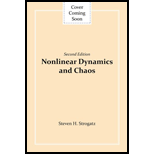
Concept explainers
Interpretation:
The relativistic equation for the orbit of a planet around the sun is
Rewrite this equation as a system in the
Concept Introduction:
Equation of orbit
Here,
A conserved quantity is a real-valued continuous function that is constant on trajectories.
Answer to Problem 7E
Solution:
The equation as a system in phase plane
The equilibrium points come out to be
It is proved that the center is a non-linear center.
The equilibrium point
Explanation of Solution
For a given solution
Here,
This kinetic energy is also called a conserved quantity because it is constant as a function of time.
The relativistic equation for the orbit of a planet around the sun is given as,
Here,
The objective is to find the equation of the given system is to be rewritten in the
Differentiate it with respect to
Substitute,
The objective is to find the system can be rewritten as,
And,
Fixed points occur for the following conditions,
And,
Substitute,
The roots of the equation can be calculated as,
Substitute,
Thus, the equilibrium points come out to be
The objective is to be shown that one of the equilibrium is a center in the
The Jacobian matrix at a general point
Evaluate the matrix at the fixed point
Substitute,
For the above Jacobian matrix determinant,
Evaluate the matrix at the fixed point
Substitute,
For the above Jacobian matrix determinant,
Thus, it is proved that one of the equilibrium is a center.
The theorem for non-linear centers states that,
A system is considered as
If a local minimum of
According to this above theorem, the center is a non-linear center provided that the fixed point is a local minimum of a conserved quantity.
The energy equation for the system can be expressed as,
Substitute,
The divergence of energy,
For the calculated fixed point, the divergence is,
Determine the matrix for the above energy equation
Here, the subscripts determine the partial derivatives.
Solve the above matrix by substituting the above value of E,
For a fixed point
Since,
Thus, the center is a non-linear center.
The objective is to be shown that the equilibrium point
It is given that,
Substitute,
This generated value is a constant as both the parameters
Thus, the equilibrium point
Want to see more full solutions like this?
Chapter 6 Solutions
Nonlinear Dynamics and Chaos
- Algebra & Trigonometry with Analytic GeometryAlgebraISBN:9781133382119Author:SwokowskiPublisher:Cengage
